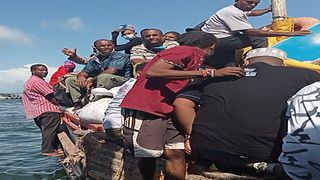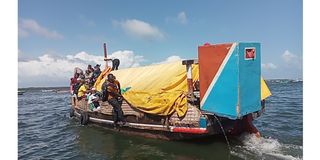
Passengers scrambling for space aboard MV Paradise water bus headed to Kizingitini in Lamu East. The journey always takes around up to 4 hours.
| Kalume Kazungu I Nation Media GroupLamu
Premium
The water buses of Indian Ocean: Journey through Lamu
The Lamu archipelago has lots of attractions, ranging from its cool aura and hospitable people to the signature donkey transporters, all of which give the impression of an easy life.
Other features of life in Lamu are lesser known. For example, unlike other parts of the world where fuel stations are located along highways and roads, the islands have something unique - floating filling stations.
These stations lie atop movable boats, from where boat operators can refuel.
Donkeys and boats are the main means of transport on the islands.
Apart from petrol-powered speed boats and diesel dhows, Lamu has large vessels specifically reserved for long distances.
These larger boats are the water buses of Lamu.
Nation.Africa sought to find out what these vessels are what it is like travelling aboard one of them.
At the mention of buses, one would expect a cosy and comfortable interior and shiny exterior, like that of a luxury long-distance bus.
But Lamu’s water buses are different - made from hard mangrove wood and exuding a tough and ugly interior and exterior. No VIP seats or special treatment whatsoever.
Everyone is in the same common class.
These buses are four times the size of your normal 60-seater bus, with the largest boasting an outrageous passenger capacity of 300.

The MV Paradise water bus full of passengers and cargo headed to Kiunga in Lamu East. The journey takes up to 8 hours.
Lamu has only two of these water buses, meaning they are scarce and in high demand, considering the large number of people shuttling daily between various islands.
Lamu has more than 60 islands, most of which are in Lamu East sub-county.
Because of the terrain and the high cost of travel, it can be hectic trying to reach these islands.
Only the water buses make it possible for people to reach them at affordable fares.
If you want to travel on one of these buses, it is essential to keep time.
This means if you waste one minute, you will have to reschedule your journey to the following day.
One water bus, the MV Shukrani, plies the furthest routes, that is, Ndau, Kiwayu, Mkokoni and Kiunga.
It leaves Lamu island at 3am and takes eight hours to arrive at its final destination in Kiunga, just a few kilometres from Somali territorial waters.
It will cost you Sh300 for the closest destination and Sh600 for the farthest.
The other vessel, the MV Paradise, plies the shortest routes to the islands of Mtangawanda, Pate, Siyu, Faza and Kizingitini, a journey that takes up to three hours for the closest destinations and five hours for the farthest.
Fare on this particular vessel range between Sh250 and Sh300.
But one should remember that travelling on water buses is not an easy affair.

Lali Shali, a boat maker in Lamu in action. He says the water buses are the safest when travelling across the vast Indian Ocean as they are less prone to accidents.
First, the journey is not meant for the faint-hearted as travellers must arm themselves with the heart of a lion and assemble all the calm from within them.
This is because all water buses have to pass through at least five renowned dangerous channels in the Indian Ocean waters in Lamu.
These channels are Mkanda and the Manda-Bruno in Lamu West, Mlango wa Tanu in Mkokoni, Mlango wa Ali in Kiwayu and Mlango wa Bomani in Kiunga, all in Lamu East.
They have been labelled ‘killer channels’ because they are located in the deepest parts of the Indian Ocean.
They are characterised by rough tides and deadly waves at all times.
Hundreds have lost their lives in these channels.
Secondly, travelling on water buses requires understanding as most of the time you should expect your fellow passengers to include animals like donkeys, goats, sheep, cats and chickens.
Another thing is that unlike vehicles, trains and planes, where you can enjoy scenic views of the outside as you travel, these water buses are entirely covered and you only get to see the outside once you arrive at your destination.
The entire vessels are covered because they ply the deepest parts of the Indian Ocean normally marked by rough seas and water could splash onto passengers and cargo if they had open windows.
The design also helps during rainy seasons and to avoid instances where the captain must stop the vessels midway in the Indian Ocean to mount a canvas roof.
Despite their size and capacity and the fact that they ply the most dangerous routes in the Indian Ocean, these water buses are less prone to accidents than your normal speed boat.
Lali Shali, a renowned boat maker in Lamu town, says the water buses have a large bottom surface area, giving them the stability required to stay stable even in the harshest of conditions at sea.
“With normal speed boats, the bottom surface area is small, contrary to those for water buses. That’s why it’s rare to witness accidents involving large water vessels. They are stable at sea, even during rough tides and waves,” he said.
But if water buses provide safer travel at sea, why are there only two of them in Lamu?
The manufacturing and buying of boats of that capacity has been the reserve of a few moneyed individuals.
Khaldun Vae, an investor in water transport in Lamu, says the bigger the boat the higher the cost.
A normal-size speed boat goes for between Sh1 million and Sh1.5 million and it takes less than a month to assemble.
Water buses, however, go for between Sh2.5 million and Sh3 million, and they take about three months to build.
In Lamu, boats are made on demand.
It is quite obvious that the demand for normal boats is higher than that of water buses and that is why the latter are few.
“The cost of production for normal speed boats is lower than the water buses. The essence is that water buses take longer to construct compared with the former,” Mr Khaldun said.
“The market demand for water buses also isn’t as high as that of these other normal boats and dhows.”
But with over 5,000 people making trips across the archipelago daily, calls are increasing for more water buses so as to meet rising demand.
“Because there are only two water buses, we have to scramble for space daily. They are always overloaded and that’s why we appeal for their number to be increased to ease the daily rush,” said Khadija Kupi, a frequent user.





